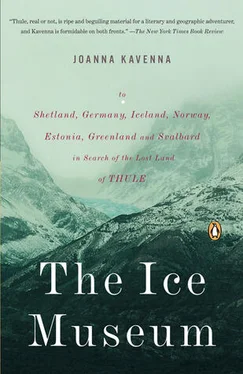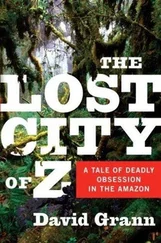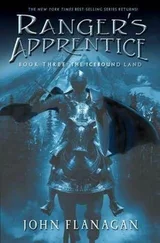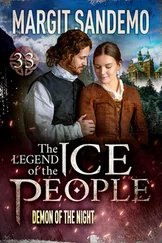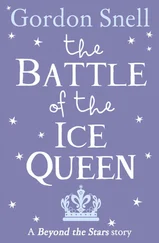Now, you could fly to the North Pole if you had the resources and mass tourism had made incursions into the northern lands. You could take a tour of Greenland and Svalbard, for the pleasures of the white mountains, the Northern Lights or the midnight sun. Wilderness treks set out across the interior of Iceland. Norway was a winter playground, offering dog sledging, reindeer herding, skiing; and in the summer the coast was full of slow-moving ferries, bringing tourists to the north. These mysterious lands, once untouched, then barely known, were now trading on their ancient credentials: their purity, their emptiness, their beauty. There was an industry in Thules—Thule tours, Thule gear, Thule knitwear shops, Thule cruises. Typing in Thule on the Internet released an array of Thule companies touting for trade, offering the sublime experience of northern wilderness. I knew that things were changing in the north. I knew there was a sombre theme in reports from the Arctic—the suggestions of climate change, the glaciers haemorrhaging ice into the fjords, the heat of the sun scalding explorers. The dour predictions hardly stopped the Thule tours; the intimations of pending destruction failed to dampen the longing for empty nature.
Further reading on the subject revealed another strain to the story, another fantasy cast onto the receptive blankness of Thule. In Munich at the end of the First World War, a sinister group met in secret under the name of the Thule Society. Members and guests of the Thule Society had included Adolf Hitler, Rudolf Hess, Alfred Rosenberg and Dietrich Eckart. The uncertain provenance of Thule meant that the word could be used by anyone who found it. It could be tied to any cause, any deranged perspective on the history of the north. For these Germans, Thule suggested the lofty origins of the Germanic race; it was from the mists of Thule that the Germans had come, they thought.
A century of wars and technological revolutions separated my sense of Thule from that of nineteenth-century explorers like Nansen, as they dabbed the word onto the scenery. The former lands of Thule had been invaded by the Germans and the Russians, sparred over in world wars. The ambiguity of the myth had been drawn into interwar hatred and extremism, though Thule was an ancient mystery, thousands of years old, and could never be reduced to a single definition, a single set of ideas. From the age of modern exploration to the contemporary age of mass travel, Thule had lingered on, a potent symbol of empty lands and silence. But what had happened, I started to think, to the idea of remoteness, the sense of magisterial nature embodied in the word “Thule”? In a hundred years explorers had mapped the most remote regions. In a hundred years, it seemed that we had passed from imagining the far north to imagining its future destruction. We had passed from the age of modern exploration—when Fridtjof Nansen, Roald Amundsen and Robert Peary set out for the northern blankness—to the age of scientific warnings about the melting of the polar ice. The subject engrossed me; it kept me in a trance, as the spring sunshine flickered across the London parks and everyone lounged through their lunch hours, reading papers in Soho Square, massing in Hyde Park at the weekends. What had happened in this wild and forceful century to an old idea like Thule? When B-52s flew across the Pole, when nuclear waste rotted in the depths of the Arctic Ocean, what had happened to a dream of a pure place, a place apart from the ambiguities of the world below?
The questions and the northern lands themselves summoned me. Thule was a traveller’s account; in its first appearance, Pytheas claimed he had really been there. And though the name became a mystery, it was a mystery intricately entwined with ideas of a particular sort of place, identified in relation to the midnight sun, to the frozen ocean. It was a word suggesting the rocks of the north, whiteness and space. It was a word suggesting innocence, a prelapsarian place. I did a faintly foolish thing. I gave up my job, a job everyone had told me I was lucky to have, and I prepared to travel through the lands that had been named Thule—from Shetland to Iceland, then to Norway, Estonia, Greenland and finally to Spitsbergen.
THE MAN OF BONE CONFIRMS HIS THRONE
IN CAVE WHERE FOSSILS BE
OUTDATING EVERY MUMMY KNOWN,
NOT OLDER CUVIER’S MASTODON,
NOR OLDER MUCH THE SEA:
OLD AS THE GLACIAL PERIOD, HE;
AND CLAIMS HE CALLS TO MIND THE DAY
WHEN THULE’S KING, BY REINDEER DRAWN,
HIS SLEIGH-BELLS JINGLING IN ICY MORN,
SLID CLEAN FROM THE POLE TO THE WETTERHORN
OVER FROZEN WATERS IN MAY!
“THE MAN OF THE CAVE OF ENGIHOUL,” HERMAN MELVILLE (1819-1891)
By way of prelude I made a trip to Oslo, to look at Nansen’s boat, the boat he made to sail beyond Thule in. I wanted to start my trail with him, with his polar ambitions and his sense of the far north. Of all the polar explorers, he was the most compelling to me. He had lived through a crux time, when a great surge of explorers was coming closer and closer to the unknown edges of the globe: the North and South Poles. Once these points were reached, thousands of years of fantasy and speculation about what lay at the extremes of the earth would be replaced by concrete knowledge. Nansen was born in 1861, when Norway was a poor country, its inhabitants struggling to survive on fishing and farming. Powered from an early age by ravenous ambition, Nansen stared intently out of early photographs, a man with blond hair and a powerful jaw, tall and strong. He looked excellent on a horse; he cut a fine figure in a uniform, but was equally suited to the rags and beards of Arctic exploration. He was a neurologist, he was awarded a doctorate; he hunched himself over microscopes in Norwegian research laboratories, but became restless. Yearning for grand vistas, the empty spaces of the north, he set off for Greenland, making the first known crossing of the ice-bound country in 1888. He returned to Norway a national hero, hailed as an explorer in the Viking tradition. In 1889, still short of thirty, he decided he needed another challenge and opted for the North Pole, a place still taunting explorers, lingering out of sight in the shadows beyond the maps. Nansen decided he would build the perfect Arctic boat, and end the ancient argument about the far north.
Writing an account of his journey towards the North Pole, a brilliant and egomaniacal description called Farthest North , Nansen reached for a way to attach his expedition to the ancient history of exploration in the far north. He rummaged in his remembered store of tales, and found the old idea of Thule. He used lines from Seneca as the epigraph to the book, creating a symbolic focus for his journey: ‘A time will come in later years when the Ocean will unloose the bands of things, when the immeasurable earth will lie open, when seafarers will discover new countries, and Thule will no longer be the extreme point among the islands.’ The extract from Seneca’s Medea hinted at it all, entwining the longings and optimism, the silence of the Arctic night and the terrible beauty of the drifting ice with the old story of the land of Thule. Nansen had been much preoccupied with the deathly kingdom he planned to enter and by the presumptuous nature of his enterprise. By opening his account with Thule he claimed a victory against the old superstitions, the dusty old pile of fantasies about the far north. Thule had been the most northerly place for the early geographers, but Nansen was aiming to clear up the lingering mysteries, and sail even beyond Thule.
The mountains were coated in frosted trees and on the streets of Oslo the snow was stacked up. The tramtracks were slender pencil lines on a white page. The pavements were coated in layers of sludge snow and ice, trampled down during the winter. Everyone shuffled on the ice, a city of people wrapped in winter clothes. Snow fell, white swirls from a blank sky. The mountains loomed into the whiteness. There was a castle, glazed with ice, and a port with boats lined along the quayside, secured by frozen chains. The city was smothered, the noises of the cars softened by the snow; the pedestrians were looking down, heads bowed against the wind, preoccupied with the ice beneath their feet. It was a city concentrating on the mechanics of motion, where everyday activities had become absorbing and difficult. I walked from the central station in a cold wind, wet snow falling onto my clothes, into my eyes and mouth.
Читать дальше
